by DAVID LANDER
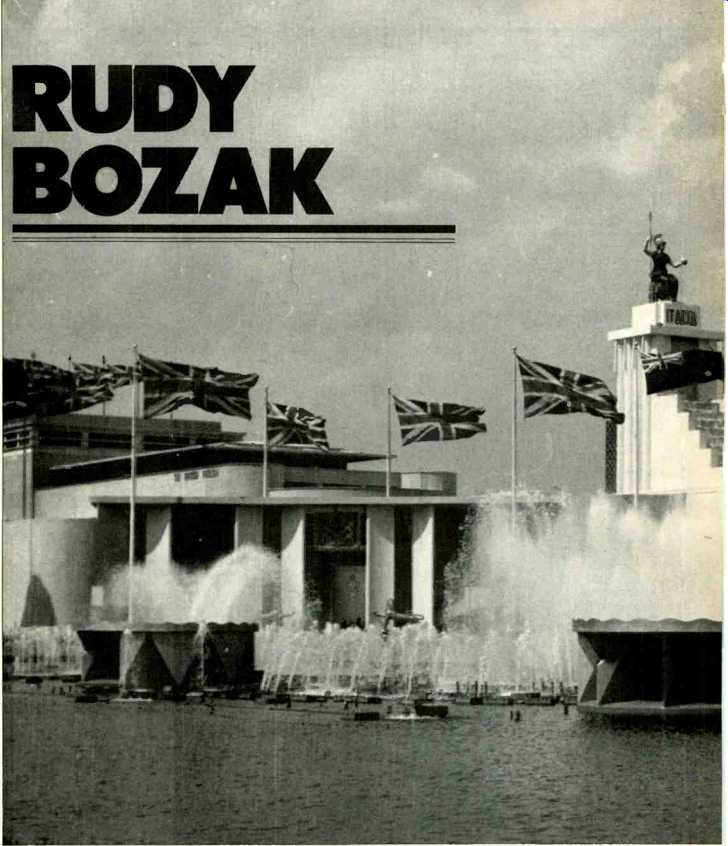
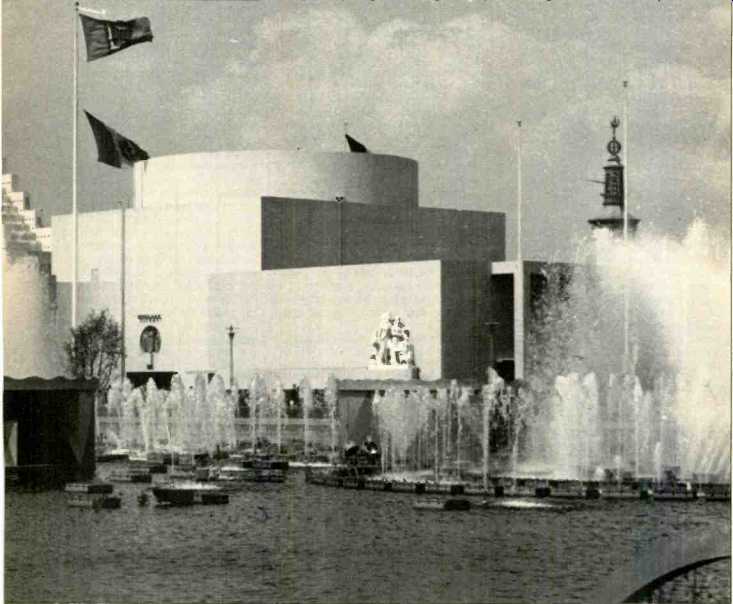
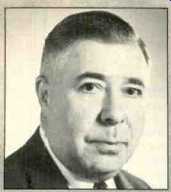
The first professional sound reinforcement installation with which Rudy Bozak was involved was the Lagoon of Nations at the 1939 World's Fair.
Sometimes it seems that irony is the pre-eminent governing principle in our universe. Audio's editor, Gene Pitts, and I had been talking for some time about interviews for this magazine,' and we agreed that one of the first should feature loudspeaker pioneer Rudy Bozak. The last lime f d interviewed Rudy was shortly before` Christmas in 1977. He had just sold his company and, though he had planned to stay on in a consulting capacity it wasn't long before he grew discontent with the direction the new management imposed and retired.
Not long before Christmas of 1981, I called Rudy at his Darien, Connecticut home. Though I had a 75-page transcript, two C-90 cassettes on file from our last discussion, I wanted to update the interview for this magazine.
Rudy always a gentleman, graciously consented. He sounded chipper as ever and, when I asked how he was getting along, said something that struck me as very healthy for á man who had not particularly wanted to retire: "I don't have the time to do the things I have to do." I never did get to Darien. CES intervened, then .some of the century's worst winter weather. On Wednesday, February 10, I returned home from Boston, where I was on assignment for Audio, to learn that Rudy had died that Monday, shortly after suffering .a heart attack at his home. The company he founded in 1949 had closed its doors in mid-January, only weeks earlier.
Born in Uniontown, Pennsylvania, on July 13, 1910, Rudoph Thomas Bozak, son of a stonemason, graduated from the Milwaukee School of Engineering in 1932. His first job, at Milwaukee's Allen-Bradley Company, was designing radio tone controls. In 1936, he moved to Cinaudagraph in Stamford, Connecticut, rising to assistant chief engineer in a year.
Bozak began his work with loudspeakers at Cinaudagraph, which designed the bass system for the Lagoon of Nations at the 1939 World's Fair, the first of many sound reinforcement installations with which he was involved.
His next job was at a band instrument company, C. G. Conn in Elkhart, Indiana, where he worked on the development of a speaker line. Rudy Bozak was fascinated by the way instruments were constructed, as well as the people involved, and later credited Conn with providing his "maximum supplemental education" in "this business of sound." After nearly five years at C. G. Conn, Bozak moved to Wurlitzer, but economic conditions in 1948 led to his dismissal, and, at the urging of friends, he decided to design, build and market a loudspeaker of his own. Using the New York audio fairs of the early 1950s as a platform and the advanced hi-fi records of his friend Emory Cook to demonstrate what his speakers could do, he began to attract the attention of a burgeoning community of audiophiles.
The Bozak plant always mirrored its proprietor's insistence on quality and craftsmanship. Moreover, Rudy felt a strong responsibility to the artisans, some of whom had been with him from the beginning, who built his products.
Visitors accustomed to the loudspeaker assembly lines so common these days were treated to the sight of woofer cones being molded from raw lamb's wool, paper and dye; midranges being stamped from sheet aluminum and then hand-turned on a lathe, and voice-coils wound by hand.
If Rudy Bozak's attitude had to be summed up in a word, it might be "concern." He cared about his employees and the products they helped create. He cared about the people who bought these products. His speakers carried a 10-year warranty because Rudy thought they should satisfy their owners at least that long.
Not surprisingly, Rudy Bozak had some distinct ideas about sounds and the high-fidelity components designed to recreate them. Excerpted from our 1977 conversation, some of these follow.
-D. L.
-- -- -- ---
When did you actually unveil the first Bozak speaker?
It was either January or February of '49 that we had our first public showing of our 201, which was a two-way system incorporating the kettle drum as an enclosure. That actually was developed at Cinaudagraph, where I was working back in 1937. It was very well-received so I proceeded to go out and peddle on my own. I made a tour from Buffalo to Boston, down the coast to New York and Philadelphia and back home, and I only made one sale on that trip. This was in about mid-year '49. And, of course, in 1949 Harry Reizes got the bright idea of putting on the first audio fair at the Hotel New Yorker.
Did you exhibit there?
I didn't buy any space at the show from Harry, but at that time they had a loudspeaker comparison on stage in the ballroom and we were invited to participate in this. We put our 201 there and it stood up with the best in the business at that time. There was Klipsch, Altec's 604, JBL, the names that prevailed at that time, and we made a definite impression. So I made another round and I still didn't hit off very well, but we struck a couple of places. Little bit by little bit we found dealers here, there, and elsewhere.
How long did it take before you were convinced your company would succeed?
The thing that really made Bozak, I must say, was that I struck up a friendship with Emory Cook, who at that time was an idealist in recording. The fact that I was an idealist in loudspeakers made for a mutual meshing of feeling there. Emory liked to dramatize things, very much so. He came to me and said, "Rudy, we want to steal the show at the 1951 audio fair. I will make some recordings and you give me a loudspeaker with good bass and good highs and we'll put this show on." Well, I proceeded, and that was the beginning of the Concert Grand. Emory went to Harmon on the New York Central tracks--two, three in the morning--and recorded passenger trains, freight trains coming through, the clonking of the rails, the horns, what have you, and it was a very dramatic recording.
So we played this and we just stole the show in 1951. The comments! Down the corridors, from around the corners, people would say, "Where are those railroad trains ?" It was a very, very realistic sound, and that was where we took off and started to fly. Cookie stole the show again in '52. He, at that time, recorded organs. He also got a group of members form the Boston Symphony--I think it was a gathering of about 30--that made a number of orchestral recordings in Symphony Hall. So we had organ and symphonic material, but the thing that was so dramatic about it was that the quality was great and there was the unbelievable realism of stereo. He called it binaural at that time. It used two cartridges. In other words, he had two bands on a record, and it was the predecessor of the stereo that we know today. That was the stealer of the show again. And in '53 he went back to Symphony Hall and recorded the 16 cycles of organ pipes, so we had to build a loudspeaker that was capable of going down to 16 cycles-the first loudspeaker that really went down and produced a genuine 16-cycle tone.
And you did that in 1953?
In '53. And it was a monster of a loudspeaker. He also recorded a chorus in Symphony Hall, and that really stunned people. I remember in one particular case Saul Marantz walking into the room just as this was going on. He folded his hands and stood there as somber as all day. It was really a stunning and paralyzing type of thing. The program material that Cook made available and the work that I put into the loudspeakers really were perfect companionship, and we carried on until Cook finally gave up on doing what he called "Sounds of the Times" pressings.
How important has your ear been to your success in designing loudspeakers?
Well, that still is one of our basic standards, the ear. And yet the ear is a very queer thing. Our reaction to what we hear is subject to a number of things, not the least of which is our disposition of the moment. You know, I built my first radio set in 1922, and my loudspeaker system was a soup plate with a pair of earphones put in it. We were tremendously impressed about how great the thing was, because in that particular instance the novelty matched everything else. It's only after continued hearing or association that people begin to be critical. We've noticed this over the years in the high-fidelity business. The neophyte would start with some cheap, pretty poor sounding thing to us-but great to him-only to find that six months or a year later he wants something better.
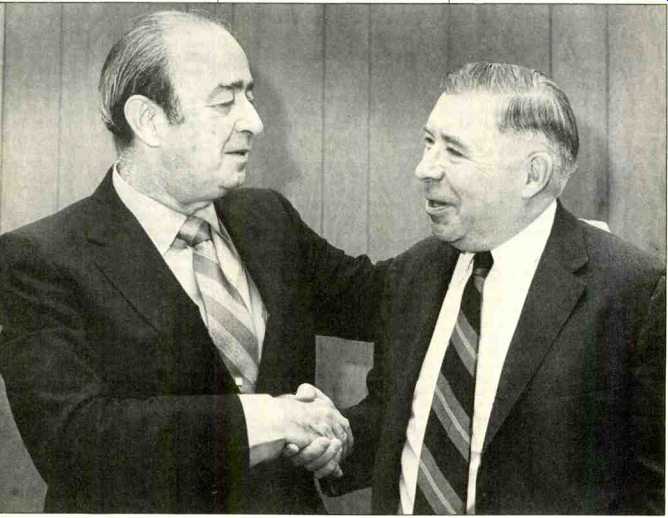
------ Audio pioneers Saul Marantz (left) and Rudy Bozak.
So the ear can be educated.
The ear educates itself in time. It does. It seems that age does to the ear something that time does to wine and other things.
Speaking of wine, connoisseurs have their own terms for describing various varieties and vintages. They'll talk about one having a big nose, for example, and another possessing a certain flinty quality. Like wines, speakers can be very different from one another. How would you describe the various sonic qualities of the best speakers you've listened to?
In bass, a sense of feel and a sense of ease. With certain types of percussive sounds, there's a punch; it puts a feel into the thing. The sense of ease is a very difficult one to describe. It's feel, but without being obnoxious. Ease is best described by the fact that you can sit and listen to the thing all day long. Nobody says, "Turn that off."
What about the rest of the frequency spectrum?
In the midrange, the property you must have is clarity because, after all, here is the range where you have the fundamentals. The basic frequencies in all of our voices, whether male or female, are only an octave apart. Middle C is 256 on the piano, and the octaves below and above that are where all these fundamentals that are demanding of clarity are found. They may fringe over a little bit, but that's essentially it. It's essentially a two-octave span that you're working with, and unless you have freedom from distortion in that region, you don't have the clarity. And in the octave above that, from 512 to 1,024, you've got to continue with your clarity. Now here is the region where you often get into trouble with cone breakup.
And what about treble? What qualities do you look for in high frequencies?
Treble is the area where you have the fill-in harmonics, which really do the final defining of sound. It's mandatory that this area be devoid of any spurious sounds or harmonic generation.
In the treble range you need a feeling of warmth and sweetness. In other words, when you listen to the musical instrument, whatever it is, there's nothing grating about it.
The woofer you designed for the 1939 World's Fair, which you've shown me a number of times, is more than two feet in diameter. Later you turned to multiple smaller woofers. Can you say a bit about this?
You want to move a lot of air, but you also want to faithfully recreate the signal, and it doesn't take very much imagination to realize that, if you have a relatively large diaphragm, it must have a substantial amount of mass. If this cone is heavy, it's going to be sluggish. Maybe it can't get up there and move. The analogy I used in the beginning days is that it's like comparing the acceleration of a freight train with that of a passenger train. The lighter, smaller guy gets off faster. That forms the basis for this multiple woofer approach which, incidentally, was not totally novel to me because Ed Kellog proposed the same type of thing about 10 years prior to my design. Of course, he was proposing eight-inch drivers, a great many of them, but it was the same basic concept. There are two other things that enter into this which I've learned over the course of my years in the business, and that is, not only do we want to have the cone light, but we also want to have it inert. A hard paper diaphragm will give you more apparent sound, but the output of that diaphragm is fraught with some inherent characteristics of the material itself. A Bozak development is a diaphragm of a light material, relatively rigid in structure and relatively dead. The reason it's dead is because it's a combination of wool and paper fiber.
You're talking about your variable density woofer. You mold these yourself, don't you, by a proprietary process?
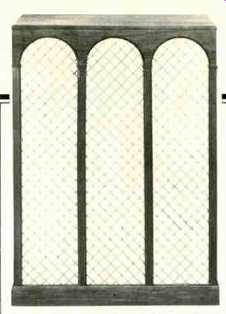
--------- Bozak's Concert Grand Model B410 Moorish-styled loudspeaker.
----- A speaker's sense of ease is very difficult to describe; it's feel but without being obnoxious. -----
A 100% proprietary process. And in addition to that there's a varying distribution of material from the apex out to the edge of the skirt. We deposit more material at the apex and it gradually diminishes as you go toward the edge. With subsequent treatment it's the basis of the variable density cone, which again is 100% unique to Bozak.
What's this variable density system all about?
Well, not only is this cone an air pump wherein we move air, but each one of those impulses from the voice-coil also propagates a wave in the material itself. By having variable density we dissipate that wave so that it doesn't go out to the edge, where it necessarily becomes reflected and gives us problems.
I'd like to get back to the importance of the ear in loudspeaker design. In your opinion, how many speaker designers have a good set of ears?
Dave, that's a very unfair question.
Well, what about your own ear? Surely it's been a factor.
Well, I think it's been somewhat of a factor. But, you see, in developing a loudspeaker you go through more than just listening to the damn thing. As I indicated, I had been indoctrinated, notably when I was at Conn, that the ear has been a contributing factor, but it is certainly not the only factor.
Then the importance of the ear can be overstated?
It could be, yes.
What other criteria do you use when it comes to evaluating one of your speakers?
Well, all the preliminary tests I subject it to.
Such as?
Tone bursts, applause ... and the spatial effects ... evaluation of the spatial coverage.
Why tone bursts?
Well, the tone burst is a qualitative figure of merit that shows how quickly the loudspeaker can respond to the initial impulse that it's excited with, and it also indicates how much the loudspeaker hangs on once the impulse has ceased.
And why applause?
Applause is closest to anything that we have to evaluate a loudspeaker system that you might term absolute. In other words, if it's distorted you recognize it. There's some character about it. Any of us who have been to a performance in a hall where we've heard applause recognize all the qualities that are in it. Of course, this applies to the upper end of the frequency spectrum, not to the overall spectrum.
If we compared one of your speakers from 1952 with one of your latest models, how different would it sound?
It would be different. To attach a quantitative number, it's difficult to say.
Do your speakers sound better with one kind of program material than another, with a particular type of music?
My standard is that if I can do a good job of recreating symphonic material, where I have a vast variety of instruments from fairly deep bass to the highest pitch and everything in between, that if I can recreate those instruments with a satisfactory degree of fidelity, then I have accomplished my goal.
Do you feel that another person could have designed these speakers?
Had he used the same tools, I don't see why not.
I'm wondering how much the personality has to do with it.
I don't think personality has anything to do with it. In other words, I don't think that my personality has entered into any of these things.
==============
( Audio magazine, May. 1982)
Also see:
Bozak Sonora Loudspeaker System (Jul. 1973)
The Audio Interview: Willi Studer (April 1981)
= = = =